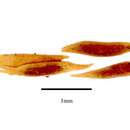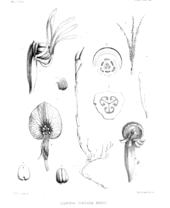zh-TW
在導航的名稱


Corsia ornata ist eine blattgrünlose Pflanzenart aus der Familie der Corsiaceae. Sie war die erste beschriebene Art der Gattung.
Wie alle Arten der Gattung hat auch Corsia ornata die Photosynthese aufgegeben und bildet dementsprechend kein Chlorophyll mehr. Stattdessen lebt sie myko-heterotroph von einem Pilz.
Corsia ornata ist eine ausdauernde Pflanze, die nur zur Blütezeit oberirdisch wächst. Aus dem kurzen, kriechenden Rhizom sprießt dann ein bis zu 25 Zentimeter langer, zylindrischer und fein geriffelter, unverzweigt und aufrecht wachsender Stängel. Das 1 bis 2 Zentimeter lange Blattwerk ist auf scheidenförmige Schuppenblätter reduziert und wächst wechselständig entlang des gesamten Stängels. Die gesamte Pflanze ist oberirdisch von purpurner Grundfarbe.
Die aufrechten Einzelblüten sind endständig und stehen an Blütenstielen, die 2,5 bis 4 Zentimeter lang sind. Von den sechs Blütenblättern (je drei Tepalen in zwei Blütenblattkreisen) sind fünf linealisch, blassgelb, 11 bis 13 Millimeter lang, einnervig und unbehaart. Das oberste sechste, das sogenannte Labellum, ist entweder hellgelb bis hell purpurn mit dunkler Nervatur oder braun-purpurn, stark vergrößert (1,2 bis 1,8 Zentimeter lang, 1 bis 1,6 Zentimeter breit) und herzförmig. Es umschließt anfangs die Blütenknospe und überdeckt nach ihrer Öffnung schützend die anderen Blütenorgane. Am Ansatz ist das Labellum direkt mit dem 1 Millimeter langen Gynostemium verwachsen, der Kallus ist weiß, breit muschelförmig, 2 bis 3,5 Millimeter lang und rund 2,5 Millimeter breit und an den Rändern fein papillös.
Corsia ornata fand man an mehreren, teils weit auseinanderliegenden Standorten in Westneuguinea, darunter insbesondere auf der Halbinsel Vogelkop. Ein einzelner Fund ist auch aus Queensland, Australien berichtet, damit ist sie die einzige Art der Gattung, die außerhalb von Neuguinea wächst[1]. Sie ist in Wäldern in Höhenlagen von 400 bis 2100 Metern auf humosen Böden beheimatet.
Corsia ornata wurde als erste Art der Gattung 1877 von Odoardo Beccari erstbeschrieben und ist daher die Typusart der Gattung. Sie wird in dieser in der Sektion Sessilis platziert, da das Labellum direkt mit dem Gynostemium verwachsen ist.
Die Informationen dieses Artikels entstammen zum größten Teil den folgenden Quellen:
Corsia ornata ist eine blattgrünlose Pflanzenart aus der Familie der Corsiaceae. Sie war die erste beschriebene Art der Gattung.
Corsia ornata is a species of flowering plant in the genus Corsia of the small family Corsiaceae, part of the monocot order Liliales. They are saprophytes (Myco-heterotrophs), lacking the ability to photosynthesise, being dependent on other organisms for their nutrition. The plant lives underground, sending up purplish stems above ground in order to flower. The leaves are reduced to scales. One of the six petal-like tepals named the labellum (a little lip), is specialised, being enlarged and hanging protectively over the reproductive organs. It was discovered in New Guinea in 1875, but has since been sighted in Queensland, Australia.
The Corsiaceae lack chlorophyll and hence the ability to photosynthesise, instead being mycoheterotrophic (deriving nutrition as parasites on fungi). C. ornata, although perennial, only appears above ground when flowering, arising from short creeping rhizomes, reaching up to 25 cm in height. From the rhizomes, arise long, cylindrical and finely corrugated, unbranched and upright growing stems that are terete (almost circular in cross section) and narrowly ribbed. The above ground portion of the plant is a purplish to purplish-red in color. Leaves are reduced to acute (sharply pointed) sheath-shaped scales 1–2 cm in length, arranged alternately on the stem, with 3–5 nerves and similar bracts. The pedicels are glabrous and 2.5–4 cm long.[2][3]
The upright individual flowers are terminal and stand on flower stems that are 2.5–4 cm long. Of the six tepals (in two whorls), five are linear, obtuse and pale yellow in colour, 11–13 millimeters long, one-nerved and hairless. The sixth, outer tepal, called the labellum, is either light yellow to light purple with a darker purple veins nerve or purplish brown. It is greatly enlarged (1.2–1.8 cm long, 1–1.6 cm wide) and cordate (heart-shaped) and obtuse, with a cordate base. The labellum initially surrounds the flower bud and, after opening, protects the other flower organs. It has a basal callus that is white, broadly shell-shaped, 2–3.5 mm long and around 2.5 mm wide, with a tip that is rounded or slightly acuminate, finely papillate at the margins with 8 or 9 lateral nerves that are variously branched and 16–18 short lamellae radiating from the basal callus that are distinctly pilose. At the base, the labellum overhangs the reproductive organs umbrella-like, the 1 mm long gynostemium (fused stamens and pistil). The 1.5 mm filaments are dark purple, the anthers dark purple to pink, 0.5 by 1 mm. The style is about 1.5 mm in length and the capsule 2.5–3.5 cm.[2][3]
Corsia ornata was first described by Odoardo Beccari in February 1875, and therefore bears his name (Becc.) as the botanical authority. It was the first species of the genus to be discovered and is therefore considered its type species. It is classified in the section Sessilis (named for their sessile labellum), the larger of the two sections of that genus, as one of 19 species.[1][3]
Corsia ornata is found at a number of widely spaced locations in the western part of New Guinea, particularly on Bird's Head Peninsula. One sighting in Queensland, Australia, makes it the only species found outside of New Guinea. Corsia ornata occurs in forests, between 400 and 2,100 m, in humus rich soils.[4][5]
 Original illustration of C. ornata. 1: Entire plant, 2: Flower with heart shaped labellum above surrounding gynostemium, remaining linear tepals below, 7,11: Diagrams of sections through ovary, 10: Seed
Original illustration of C. ornata. 1: Entire plant, 2: Flower with heart shaped labellum above surrounding gynostemium, remaining linear tepals below, 7,11: Diagrams of sections through ovary, 10: Seed Corsia ornata is a species of flowering plant in the genus Corsia of the small family Corsiaceae, part of the monocot order Liliales. They are saprophytes (Myco-heterotrophs), lacking the ability to photosynthesise, being dependent on other organisms for their nutrition. The plant lives underground, sending up purplish stems above ground in order to flower. The leaves are reduced to scales. One of the six petal-like tepals named the labellum (a little lip), is specialised, being enlarged and hanging protectively over the reproductive organs. It was discovered in New Guinea in 1875, but has since been sighted in Queensland, Australia.
Corsia ornata là một loài thực vật có hoa trong họ Corsiaceae. Loài này được Becc. miêu tả khoa học đầu tiên năm 1878.[1]
Corsia ornata là một loài thực vật có hoa trong họ Corsiaceae. Loài này được Becc. miêu tả khoa học đầu tiên năm 1878.